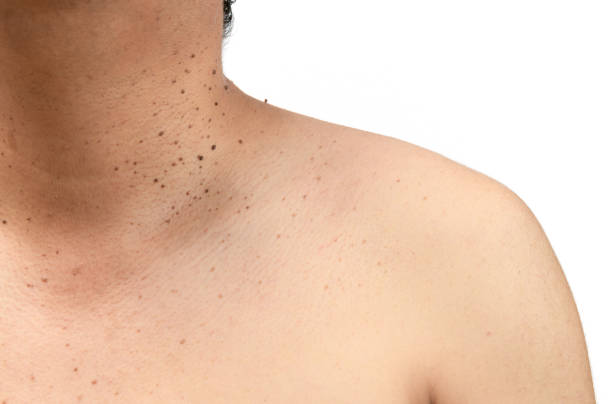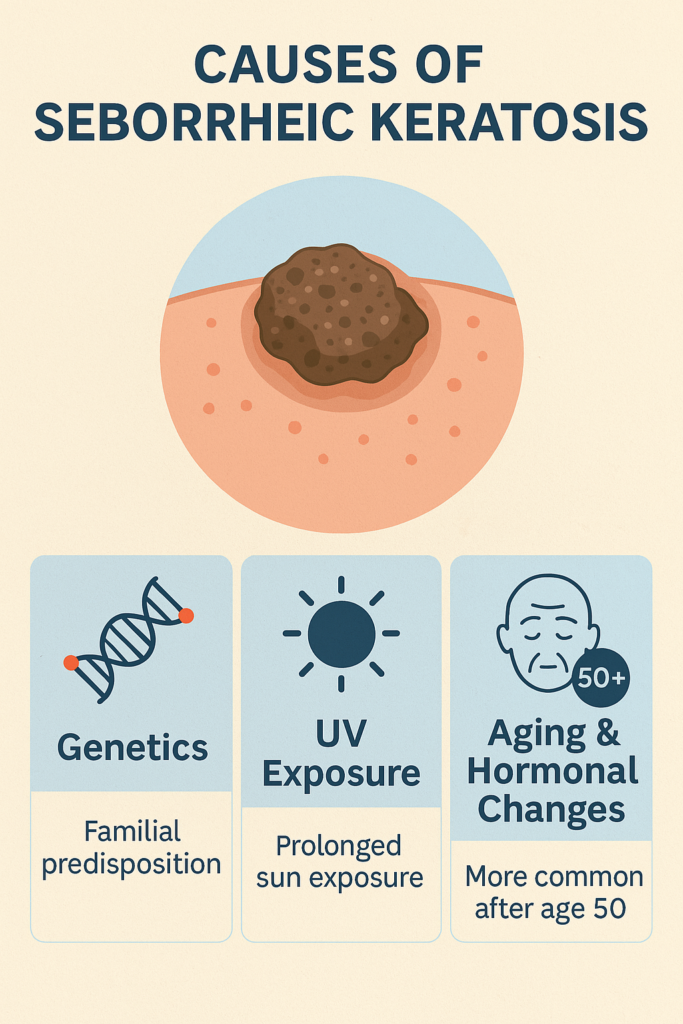Seborrheic keratosis is a benign growth on the skin that affects millions of people worldwide, especially in the UK and the USA. Despite its prevalence, many individuals remain unaware of the reasons behind these bumps. More importantly, they do not know how to recognize the symptoms or seek effective treatments. Therefore, this guide aims to introduce you to seborrheic keratosis, share knowledge from the most recent scientific literature on the condition, and facilitate your learning about managing and removing unwanted seborrheic keratosis.

What is Seborrheic Keratosis?
Seborrheic Keratosis (SK) is a noncancerous skin condition that presents as wart-like, scaly, or waxy growths. Seborrheic keratosis is a common benign skin tumor in humans; over 80 million Americans are affected. As people age, the occurrence of SK increases. These lesions may appear tan, brown, or black, vary in size, and are sometimes mistaken for cancer.
Seborrheic Keratosis Causes: What Science Says
Seborrheic keratosis, unlike acne or eczema, is not caused by infection or inflammation. Studies suggest that a combination of genetic factors, UV exposure, and aging is associated with it. Here’s what you need to know:

Genetics:
People with a family history of seborrheic keratosis are more likely to develop the condition.
UV exposure:
Prolonged exposure to sunlight can accelerate the development of SK, even though it is not the primary cause.
Aging & Hormonal Changes:
As people age, their skin regenerates more slowly, making SK more likely to form.
Prevalence:
An Australian study reported a 100% prevalence of SK among individuals over the age of 50, with an average of 69 lesions per patient in those over 75.
Seborrheic Keratosis Symptoms & How to Identify It
Identifying symptoms early can support appropriate diagnosis and treatment. Important symptoms include:
- Waxy, scaly, or rough patches on the skin
- Colors could vary from pale tan to brown or
- Black, Round or oval in shape, may occur anywhere on the body (may be seen on the face, neck, chest, and back). Painless, but may itch or become irritated.
Seborrheic Keratosis vs Skin Cancer: Key Differences
Many people confuse SK with skin cancer. Here’s how to tell the difference:
| Feature | Seborrheic Keratosis | Skin Cancer (Melanoma) |
| Texture | Waxy, rough, scaly | Smooth or irregular |
| Color | Tan, brown, black | Uneven shades with red/blue |
| Growth Pattern | Gradual | Rapid changes |
| Borders | Well-defined | Irregular |
| Bleeding | No | Often bleeds |
If unsure, it is best to consult a dermatologist for a biopsy.
How to Remove Seborrheic Keratosis: Best Treatments
Procedures Approved by a Dermatologist
Cryotherapy (Freezing Procedure): Liquid nitrogen is used to eliminate SK cells.
Electrocautery: Electrical currents are used to burn off lesions.
Curettage (Scraping): Removes growths without scarring.
Laser Therapy: Research says YAG lasers offer a one-step procedure, which is a very simple and economic treatment and provides an alternative treatment method with better cosmetic results compared to cryotherapy.
Seborrheic Keratosis Natural Treatment & Home Remedies
Many people prefer natural alternatives. Here are home remedies backed by science:
Aloe Vera & Vitamin E
A 2019 study in the Iranian Journal of Medical Science found aloe vera to contain anti-inflammatory and skin-repairing properties.
- How to Use: Apply fresh aloe gel mixed with vitamin E oil on the lesion twice daily.
Green Tea Extract
Packed with antioxidants, green tea polyphenols reduce oxidative stress and can slow SK growth.
- How to Use: Brew strong green tea, let it cool, and apply with a cotton pad.
Apple Cider Vinegar (ACV)
Studies show ACV exfoliates dead skin cells, which makes it a gentle option for SK removal.
- How to Use: Dilute ACV with water, apply to SK spots, and rinse after 15 minutes.
Precautions & Mistakes to Avoid
While home remedies can be helpful, avoid these common mistakes:
Picking or scratching – Can lead to infection
Using Undiluted ACV – May cause burns
Overusing Harsh Exfoliants – Triggers irritation
Skipping Sunscreen – UV exposure worsens pigmentation
Safe Skincare Routine for Managing SK
| Morning | Night |
| Gentle Cleanser | Exfoliating Cleanser (2-3x per week) |
| Vitamin C Serum | Retinol or AHA Serum |
| Moisturizer | Deep Hydration Cream |
| SPF 50 Sunscreen | Repairing Night Cream |
Is Seborrheic Keratosis Dangerous?
No, it is not cancerous. However, if a lesion changes rapidly, bleeds, or becomes painful, seek medical advice immediately.
Final Thoughts: Take Control of Your Skin Health
Seborrheic keratosis is a harmless and common skin condition, and removal is not necessary for medical reasons, although many people seek treatment for cosmetic purposes. Whether you opt for dermatology treatments, natural skin care, or over-the-counter creams you can find in drug stores, consistent treatment and protection from sun damage will help prevent new lesions. Be sure to check with a dermatologist first before trying anything new!
Discover more from The Healthcare Diary
Subscribe to get the latest posts sent to your email.